October 2019
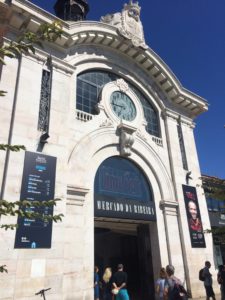
Discovered by accident whilst running errands, but all the more enjoyable for that diversion, were the Mercado da Ribeira, opposite Cais Sodré on the waterfront. A cornucopia of fresh and exotic fruit and vegetables, as well as fish and shellfish, and many of the stallholders speak English. The adjoining hall is the Time Out Market, a buzzing food hall offering a wide variety of cuisines prepared by top chefs, as well as delicatessens and wine merchants.

Tucked beneath the soaring arch of the suspension bridge is the LX Factory, an area of disused and partially derelict buildings that has been reimagined into a thriving community of food, arts and crafts. Visit with an open mind, and be prepared for the unexpected!
Some notes from the Internet of points of interest in the city
Belém District – the waterfront
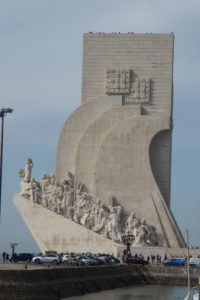
Monument to the Discoveries: Padrão dos Descobrimentos, a sculpture beside the Tagus, commemorating the golden age of Portuguese history. This huge stone caravel was built in 1940 for the Portuguese World Expo by the architect Cottinelli Telmo and the sculptor Leopoldo de Almeida. It was only given permanent status in 1960 to celebrate the fifth centenary of the death of Prince Henry the Navigator. It features the main navigators: Bartholomew Dias – who turned the Cape of Torments into the Cape of Good Hope; Vasco da Gama – who discovered the maritime route to India; Pedro Álvares Cabral – who discovered Brazil; and Magellan – the first European to cross the southern Pacific and circumnavigate the earth. Visit the Discoveries Cultural Centre; climb to the top to get a unique view of Praça do Império; and be inspired that, in the 15th century, small caravels set sail from this point to face the world’s oceans. Look for the vast tiled map of the world set into the waterfront promenade, showing the Portuguese in the Timor Sea in 1512.
Maritime Museum: a journey through one of the most fascinating aspects of the history of mankind: the maritime adventure. The Maritime Museum was founded by King Luís on 22nd July 1863, in order to promote Portuguese maritime history. The collection began during the 18th Century with the gathering of several ships of the Royal Navy. Today, the Museum owns over 17,000 items, 2,500 of which have been selected to be a part of the permanent exhibition. During the visit you will see objects of many different kinds produced by people of many cultures, observation of which may provide a glimpse, not only of the environment that gave rise to them, but also of the influences that marked them.
Fundação Centro Cultural de Belém: designed to function as an “open city” to celebrate culture, opening its intensive programme of activities to all kinds of cultural events.
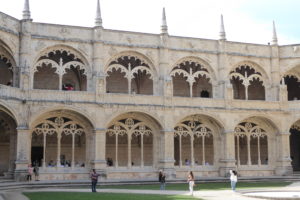
Jerónimos Monastery: proclaimed a UNESCO World Heritage Site in 1983. This notable 16th Century work of architecture became part of Portuguese identity and culture, symbolic of Portugal’s power and wealth during the Age of Discovery. In an architectural style known as Manueline, King Manuel I built a large monastery near the location where the Infante D. Henrique ordered a church to be built in the mid-15th century by invocation of St. Mary of Belém. To immortalise the memory of the Infante, for his intense devotion to Our Lady and faith in St. Jerome, in 1496 King Manuel I decided to found the Monastery of St. Mary of Belém, near the city of Lisbon, next to the Tagus River. Donated to the monks of the Order of St. Jerome, a pantheon of the Avis-Beja Dynasty, in the 19th Century the church became the sepulchre for heroes and poets: Vasco da Gama and Luís de Camões. Vasco de Gama and his crew spent their last night here in prayer before leaving for India and their historic voyage. His tomb is in the monastery. Maritime motifs play a significant part in the design. The Chapter houses the tomb of Alexandre Herculano, a Portuguese novelist, poet and historian. An interesting exhibition explains his important contribution to liberal politics and Romanticism.
—–
An iconic sight in Lisbon, the single carriage Remodelado trams trundle all over the city amongst all the modern street traffic. The E24 is a newly opened tram route connecting Praça Luís de Camões to Campolide, and as it is less famous than the E28, there are always seats available.
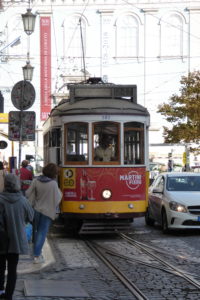
The romantic number E28 tram follows the route Martim Moniz – Graca – Portas do Sol – Se Cathedral – Rua Conceição (southern Baixa) – Chiado – Sao Bento – Estrela – Campo Ourique. Notable stops en route include:
Graca – A district that is truly Portuguese, and a great location to experience normal Portuguese daily life. There may not be many actual sights in Graca but is an enjoyable district to explore, with a pleasant high-street of family-run shops and bustling cafes. Get a glimpse of the inside of the houses that decorate the climb up to Graça.
Portas do Sol – A very popular and scenic plaza in Alfama, which has a wonderful view over the district and Tejo Estuary. This is also the location of the Museu de Artes Decorativas and closest stop for the castle. The Alfama district is dominated by the Moorish Castelo de São Jorge. It is one of the oldest quarters in Lisbon, and mostly survived the 1755 earthquake. Much remains of its original layout, as it was before the district was recaptured from the Moors in 1147, and Moorish influences can still be heard in the haunting music which can be heard in the cafés.
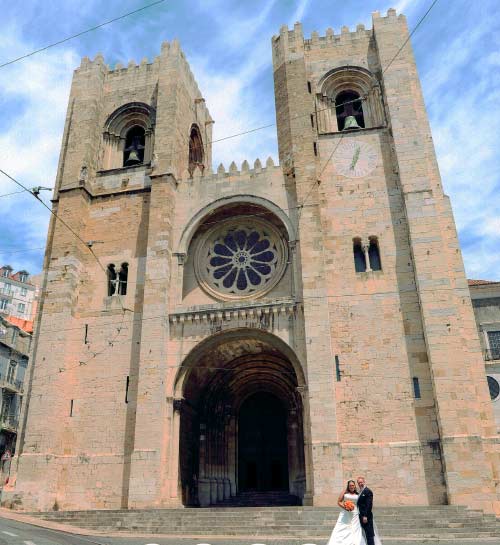
Se Cathedral – Tram stop outside the ancient Se Cathedral and Saint Anthony Church. Saint Anthony is the patron saint of Lisbon (along with lovers and lost causes) and the Igreja de Santo António was constructed on his birthplace.
Rua Conceição – The tram stop at the southern side of the Baixa district, which is close to the pedestrianised street of Rua de Augusta and the Praça do Comércio, Lisbon’s finest plaza. Terreiro do Paço, (Praça do Comércio) Take a rest at the feet of King José I and the imposing horse Gentil, a statue sculpted by Machado de Castro which so well illustrates royal power and the nobility of the Lusitano breed. On the square is the Lisboa Story Centre – Memories of the City: this interactive technology-based facility relates the main events in the city from past to present.
Sao Bento – The setting for the Portuguese parliament building, which is housed in the grand Assembleia da República. An underrated and little-visited district of Lisbon, worthy of a detour from the common tourist areas.
Estrela – A calm and prosperous district. The tram stops in front of the Basílica da Estrela with its ornate Baroque façade and huge white domed roof marking the skyline – one of the most impressive and attractive churches in Lisbon, neoclassical 18th Century. Its two bell towers peal charmingly, while its paintings by Pompeu Botoni and Pedro Alexandrino accentuate the baroque style of its interior. As a simplified replica of the Convento de Mafra, it is also the result of a vow made by the queen in the hope of producing a son and heir. The interior, decorated with marble of every colour, houses the queen’s majestic tomb, and a unique nativity scene made of 500 cork and terracotta pieces. Opposite the Basilica is the pleasant Jardim da Estrela, a popular park among Portuguese families and a great place to relax after a long day of sightseeing.
Praça Luís de Camões – The main plaza of Bairro Alto, a chaotic and hectic plaza where there is always something going on. The narrow streets of Bairro Alto come alive at night with funky bars and trendy hangouts, and at the weekends the socialising spills out onto the streets. The district has imposed a closing time of 2am to try to control the chaos, and this is when most revellers head to Cais do Sodre.
Anjos – A multi-cultural and diverse selection of the city, some visitors will embrace the diversity while others will think it is a bit shabby.
Casa dos Bicos: one of the most fascinating houses in Lisbon, returned to its past glory after the José Saramago Foundation took up residence. It belongs to the Museum of Lisbon. Behind its façade of diamond-shaped stones lies the personal library of the Nobel Prize-winner for Literature in 1998. It also houses an exhibition about his life and work. Outside, under an olive tree, lie the ashes of one of Portugal’s greatest authors. But the building’s history dates back further, to 1523 and the son of the second governor of Portuguese India. Inspired by the Italian Renaissance and the palaces of Bologna, he decided to build one for himself. But the symmetry of the doors and windows was neglected. The end result is a house which looks like a door into an enchanted kingdom. Considering the vast library inside, the description is very apt.
Portuguese paving, calçada portuguesa, is one of Lisbon’s trademarks. Playing a huge role in creating the city’s special atmosphere, as it reflects all of the light that falls on it, it is also one of the oldest features of the city. Made using limestone cubes shaped and placed by hand by skilful craftsmen, the designs can be geometric, figurative or specific depending on the particular location and the tastes of the time. Enjoy the undulating pattern in Avenida da Liberdade or stand back and observe the symmetry of the design in Chiado.
Lisbon’s Streetlamps: Lisbon is famous for its unique light. But the lights and streetlamps that illuminate the city at night are also special. Their construction, made of forged and cast iron and concrete, is representative of the Romantic and modern styles that gradually decorated the city. Often adorned with the symbol of Lisbon – a caravel with two ravens – they can be found in the traditional quarters and the Avenidas Novas.
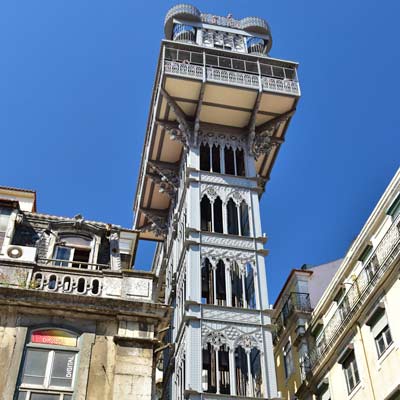
The Elevador de Santa Justa is one of the city’s most famous sights. Designed by Mesnier du Ponsard, it was originally called the Ascensor Ouro-Carmo. It connects Rua do Ouro to Largo do Carmo via a neogothic-style structure completely unlike any of the other elevadores in the city. The lifts themselves, made of wood elegantly decorated with brass, evoke a journey in time as they ascend and descend towards the most exclusive areas of the city. At the top of the tower is one of the best viewing points in the city, providing a splendid panorama of Baixa, Castelo, the Tagus and also the impressive ruins of the church of the Convento do Carmo.
Church and Convent of São Vicente de Fora: Besides having one of the most important churches in the city, the artworks inside are unique. Not just to discover a place erected after the taking of the city in the Christian reconquest, but also to see one of the grandest religious buildings in the capital. Of the original Romanesque church promised by King Afonso Henriques to St Vincent – the patron saint of Lisbon – little remains, except the original site of its construction. The extraordinary Mannerist complex you can visit today was begun in the last years of the 16th century and it was Filipe II of Spain who ordered the reconstruction of a monument known for its simplicity, symmetry and balance. Climb the imposing steps and discover the stone-lined and marble-decorated church, where the chapels of Santíssimo and Nossa Senhora do Pilar stand out for their age and exquisite decoration. The high chapel also has a Baroque altar requested by King João V and the organ from São Vicente, one of the best in Lisbon. It is also recommended that you visit the Sala da Portaria at the entrance to the monastic quarters.
Aqueducts and Mãe d’Água: An essential part of Lisbon to get to know on foot. Drop in at the Arpad Szenes-Vieira da Silva Foundation and its garden nearby for an unforgettable day. Visiting the aqueducts and reservoir in Amoreiras is a way of admiring the ingeniousness and care that was put into building these unique structures in Lisbon. The reservoir is located in the Jardim das Amoreiras, one of the spots in the city most appreciated by the locals in summer and on sunny but cool days. Designed in 1745 and completed in 1834, this is the impressive site where the water brought by the aqueduct collected. A look inside is well worth it, where the power of the waterfall and expanse of water is emphasised by the sober architecture. You can also find out more about it and the aqueducts at the Museu da Água (Museum of Water), an interesting and original place to visit.
Linhas de Torres Route: Have you ever wondered how Portugal managed to stop Napoleon’s army from reaching Lisbon? The Historical Lines of Towers Route (HLTR) is a cultural tourism project that aims to restore and draw attention to the military heritage that was created in the early 19th Century by the Anglo-Portuguese forces under the Duke of Wellington. The line of towers was built to defend Lisbon against the Napoleonic invasion. The route, which crosses six different municipalities, takes in a total of 152 fortifications that defended Lisbon against Napoleon’s army. Besides Loures, the route also passes through the municipalities of Mafra, Torres Vedras, Arruda dos Vinhos, Sobral de Monte Agraço and Vila Franca de Xira.
Macau Scientific and Cultural Centre: Important collections of Chinese art and the only historical-cultural Museum about Macau outside the People’s Republic of China. The Museum is the most public face of the Macau Scientific and Cultural Centre through its permanent exhibition, temporary exhibitions and its many other activities. The use of modern and dynamic language, didactic and interactive language is supported with the latest technologies so as to attract the attention of the young as well as the general public. The Museum aims to inform the public of the essential condition of Macau as Portugal’s and Europe’s meeting point par excellence with China. It also strives to highlight the importance of the thousand-year-old heritage of the Chinese civilization and it is one of the most important collections of Chinese art in the Iberian Peninsula and the only historical-cultural Museum about Macau outside the People’s Republic of China.
Museu do Oriente: A compelling reference both for Lisbon and Portugal and a European milestone bearing witness to long lasting relationship between Portugal – the first country to reach the East – and the peoples of Asia. The heritage that forms the core of the permanent Museu do Oriente exhibition is fundamentally divided up into two main collections: The 1st collection, alluding to the Portuguese presence in Asia includes over a thousand artistic and documental pieces, some with exceptional value such as the range of 17th and 18th century Chinese and Japanese folding screens, various examples of highly rare Namban art, a Company of Indies porcelain collection or the significant collection dealing with the cultures of the peoples of Timor. The second collection, the Kwok On Collection with over 13,000 pieces related to the performing arts of a geographic area extending from Turkey right across to Japan. A special highlight is the nucleus of pieces related to the rituals of Hinduism, Bhudism, and even to animist religions or xamanic cults. An important collection of masks from all around Asia, and shadow and puppet theatres from India, China and Indonesia, must also be emphasized.
Museum of Aljube – Resistance and Freedom: Discover the Museu do Aljube – Resistência e Liberdade whose name belies its aim: to remember and document the struggle against Portugal’s dictatorship. An activist museum with a clear purpose: to remember and document the struggle against the dictatorship which governed Portugal from 1926 to 1974. Represented here is resistance in the name of freedom and democracy, a tribute to all those who fought and risked their lives during the years of continuous struggle and for which they were often persecuted and denounced. Housed in the Aljube building, which dates back to the Moorish era, its name means “dry well”, “cistern”, “dungeon” and “prison” – a role which it almost always fulfilled. It was a political prison from 1928 to 1965 and has now seen its purpose reversed, examining in an informed and informative manner the ways in which fascism was resisted and fought against. It’s worth learning more about this period in Portugal’s recent history.
Museum of Fado: Discover the best fado singers and guitar players. Fascinating performers, sublime guitarists and inspired composers come together at this museum to celebrate Portugal’s traditional music. Besides representing one of the region’s most important cultural legacies, it also has a restaurant and a themed shop where you can spend some time to catch the spirit of saudade (nostalgia). Totally devoted to fado and the guitar, it has a permanent exhibition and temporary ones, alongside a document centre and an auditorium with regular events and a very interesting programme. With songs by the greatest Portuguese artists illustrating an art form that Portugal gave to the world, the museum’s artistic quality will surprise you. The restaurant serves typical Portuguese food and helps to give your visit a traditional flavour. But technology, in the form of interactive stations documenting fado’s history throughout the museum and audioguides allowing you to listen to dozens of fado songs composed and sung down the decades, lets you delve further into history. Time and the music fly, in a restored building of national interest right next door to the neighbourhoods where you can hear fado being sung at night.
Pharmacy Museum: The history of pharmacy and health is told over more than 5000 years of history, with objects of different cultures and civilizations and with reconstructions of authentic pharmacies. The history of pharmacy and health is told over more than 5000 years of history in different cultures and civilizations like Mesopotamia, Egypt, Greece, Rome, the Incas, the Aztecs, Islam, Tibet, China, Japan, etc. The history of pharmacy in Portugal is told by reconstituting authentic Portuguese pharmacies from the old pharmacy of the eighteenth century, until the Liberal Pharmacy of the early twentieth century and still reconstitution of an authentic traditional Chinese pharmacy, coming from Macau by the end of 19th century. The history of pharmacy ends with the great discoveries and scientific advances in health in the twentieth century, as a gift to humanity carried out by the discovery of penicillin and the new era of antibiotics and more recently the discovery of the sequence of the molecular structure of DNA. The exhibition ends with an area dedicated to Pharmacy in space, with drug kits that were on board the Space Shuttle Endeavour in December 2001.
Shaaré Tikvah Synagogue Rua Alexandre Herculano, 59. If you want to visit the Lisbon synagogue in the São Mamede quarter, you’ll need its exact address. Opened in 1904, the temple is indistinguishable from the street, built at a time when it was forbidden for any faith or religion other than the Catholic Church to be openly visible. Its construction combines Roman, Byzantine and Romantic elements and is austere in style, with the temple built facing in the direction of Jerusalem. The columns supporting the galleries highlight the bimah and desk, which identifies the place of celebration. See also the Ark, where the Torah scrolls are kept. If you want to learn more about Jewish culture and its impact on Lisbon, take a tour organised by the Jewish Community of Lisbon which visit the old Jewish quarters and the surviving traces of the old Alfama Synagogue. It’s well worth learning about the presence and influence of this community in Lisbon.
Torre de Belém: UNESCO World Heritage, a cornerstone of Portuguese identity and an icon of a country historically moulded by its proximity to the ocean and its maritime discoveries of new worlds. Discoveries by Portuguese navigators transformed Lisbon into the world’s main trade hub in the 15th and 16th centuries. To protect the city, King João II conceived a pioneer project to defend Lisbon from enemy ships, a work completed in 1514 and which included the building of the Belém Tower, designed by architect Francisco de Arruda. The tower’s unique design includes a modern and heavily armed bastion, protruding over the river. King Manuel I clearly wished the Belém Tower to stand as a lasting symbol of his powerful reign by depicting the royal coat of arms, the armillary sphere and the cross of the Order of Christ.

